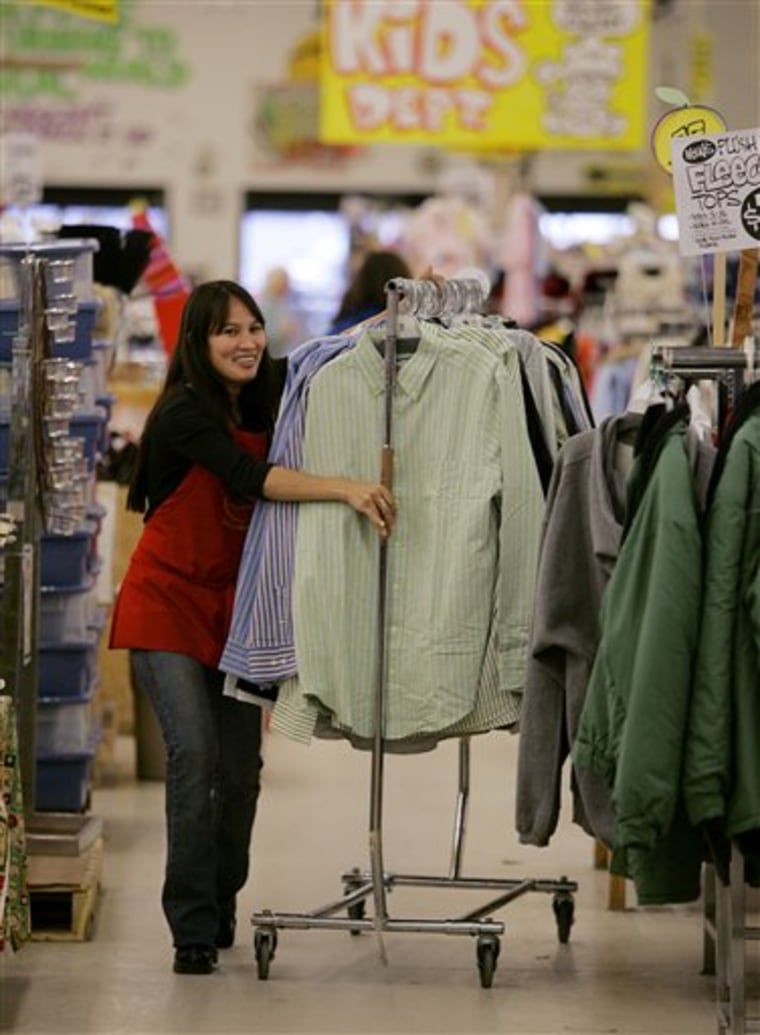Paul Murphy went bargain hunting at a discount store called Building 19, and ended up with quite a find: A charcoal gray wool men's suit for $66 that he found priced at $329 at a major department store.
"I bought two of them — one for me and one for my son," the 62-year-old piano salesman from Scituate, Mass. said after a visit to a downtown Boston tailor to have the pants altered.
The suit was part of a windfall of closeouts that discounters are snapping up as department stores and wholesalers unload a glut of fall and winter fashions. Unseasonably warm early fall weather and shoppers worried about the economy left stores with unsold merchandise taking up sales floor space heading into the crucial holidays.
Off-price retailers are feasting on overstock of cool-weather clothing at prices far below what traditional retailers originally paid — deals expected to help discounters boost their profits. And they may pass on some of their benefits to consumers in the form of steeper-than-usual discounts and a fresher apparel selection.
Building 19 initially planned to offer the $66 suits for $79, but went with the lower price out of expectations that traditional retailers' oversupply of cooler-weather clothing would grow, leaving shoppers with a wealth of discount opportunities.
"There are always bargains around, but this is unusual," said Jerry Ellis, who co-founded the 14-store New England chain, a self-described "bottom of the barrel" retailer of salvage merchandise, in 1964. "The traditional vendors are almost desperate."

Although retailers have become increasingly sophisticated at adjusting merchandise to fit demand, their predictive powers were no match for the unseasonably warm early fall, coupled with high energy and food prices and a slumping housing market, said Stephen Hoch, head of a retail studies program at the University of Pennsylvania's Wharton School.
"The whole supply-chain system is clogged up, and it could take four to six months for all this to clear up," Hoch said. "It's kind of like plumbing."
Off-price retailers, he said, "are seeing a big influx of better inventory than they might normally have."
The situation isn't a guaranteed bonanza, since the discounters may have to extend deeper-than-usual price cuts to win business from consumers anxious about economic factors.
"Consumers see apparel as a discretionary purchase, and coming into the holiday season, they know they are going to need their dollars for gifts," said Phil Rist of the market research firm BIGresearch.
Analysts say the off-price retailers are clearly having an easier time than department stores and mall-based apparel vendors that have been scaling back holiday sales expectations. J.C. Penney Co. slashed its fourth-quarter outlook Thursday and reported third-quarter profit fell 9 percent. Chairman and Chief Executive Myron E. "Mike" Ullman III said the holiday season would be marked by lots of price-cutting.
Twice as many major retailers missed Wall Street's expectations compared with those who beat projections in their October sales. The list of those missing included such names as Macy's Inc. and Nordstrom Inc., and it was the slowest October for U.S. retail sales growth in 12 years, according to a tally by the International Council of Shopping Centers-UBS.
But off-price retailer TJX Cos., owner of 2,500 stores including T.J. Maxx and Marshalls, beat expectations for the second month in a row, with a 3 percent same-store sales rise in October. Warehouse operators Costco Wholesale Corp. and BJ's Wholesale Club also did well last month.
In announcing an 8 percent rise in third-quarter earnings on Tuesday, TJX President and Chief Executive Carol Meyrowitz described "a market full of buying opportunities" for her firm heading into the holidays.
"The level and quality of goods out there is amazing," Meyrowitz told analysts.
There's always inventory give-and-take between retailers and wholesalers. But Hoch said an unusual number of department stores are trying to win concessions from suppliers to help absorb unsold apparel costs, including negotiating to return inventory or secure discounts for future orders.
To move merchandise and free up rack space, some retailers are offering sales and running special promotions earlier than usual before the traditional kickoff to holiday shopping on the day after Thanksgiving.
"What's happening right now is consumers aren't shopping," said Patricia Walker, a partner in the consulting firm Accenture's retail practice. "Once retailers put deals out there, it's unclear if consumers will look for them in at the department stores, at the specialty stores, or the discounters. Certainly, the discounters will be offering better products than they have in the past."
Overstock.com has managed to acquire fresh fall and winter fashions two months earlier than usual, at a time when discounters normally can offer little current apparel, said Patrick Byrne, chairman and chief executive of the Salt Lake City-based online retailer. For example, a Baby Phat women's bomber jacket that was selling online for $180 at Macy's this week was available at Overstock.com for $94.99.
To capitalize on the opportunity, Overstock.com is boosting fourth-quarter advertising spending by a third.
And because Overstock.com has secured batches of apparel at steeper-than-usual discounts, it's been able to keep a healthy margin. In October, Overstock's profits from coats, boots and sweaters more than tripled from a year ago, Byrne said.
The unseasonably warm early fall weather also enabled discounters to sell traditional retailers' end-of-summer overstock of warm-weather clothing in the early fall. North Kingstown, R.I.-based discounter Ocean State Job Lot bought 200,000 short-sleeve print T-shirts, and decided to put them on the sales floor in September at $4 apiece rather than wait until May.
"Instead of being hurt by having a bomber jacket on the floor when the weather outside was nice, we were able to sell summer apparel into the fall," said Marc Perlman, the chain's chief executive. "This summer didn't seem to want to go away."
